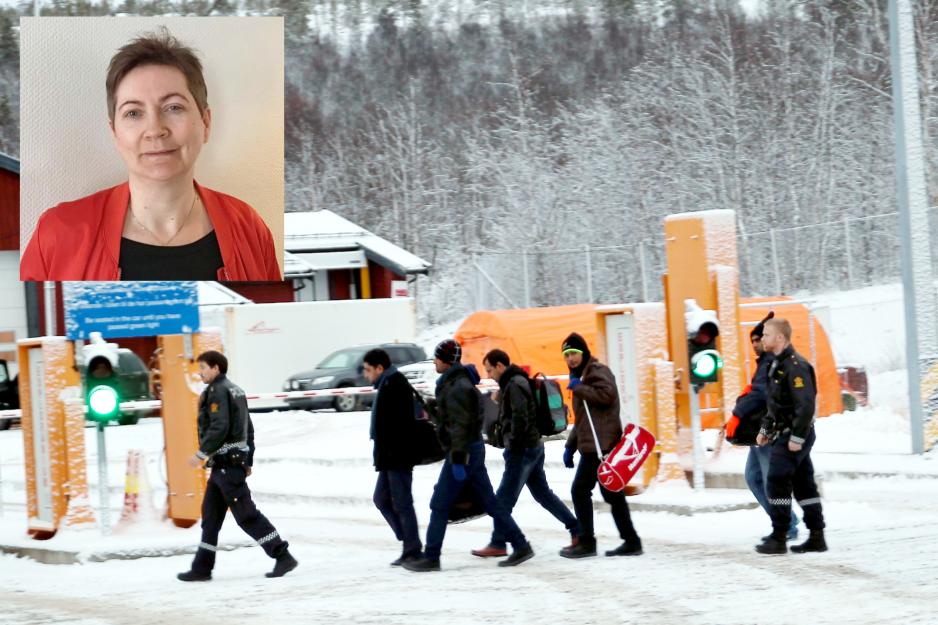Arne O. Holm says First, We Bombed Them to Pieces. Then We Build Walls to Keep Them Out

After the collapse in Afghanistan, the scare images from the refugee flow across the border from Russia to Norway are brought back. The mayor of Sør-Varanger municipality, Lena Norum Bergeng, will continue to extend a helping hand to people in need. (Photo: Sør-Varanger municipality / Archive photo: Amund Trellevik).
Commentary: First, we bomb them to pieces. Afterwards, we build walls to keep us in and them out. I feel the green branch I am sitting on swaying perilously.
Viewing the evil of the world from one of the most peaceful places on earth may be demanding. Not physically or economically, but mentally.
Because while the Afghan society is collapsing, images of an undesired flow of refugees once again appear on our retinas. Pictures from newspaper archives showing refugees on bicycles crossing the border from Russia to Norway at Storskog border crossing in the High North.
Refugees meet journalists
Back then, in the winter of 2015-2016, the refugees did not only meet closed borders. They were also vilified by some within my own profession.
It still gives me the shivers when I think back at the rhetoric used in the covering of those who tried to enter Norway from Russia. The largest newspaper in the High North, the daily Nordlys based in Tromsø, outlined one terrifying scenario after the other. The paper had, amongst others, calculated that some 57,000 refugees might cross the border.
Or, well, refugees.
In the words of the paper, it was all about “people who [saw] and opportunity to a better life and better future prospects. Understandable, however, they are not refugees.” They were fortune hunters. Their need for protection was apparently so unfounded that Nordlys in two editorials stated that 95 percent of them would be kicked out again. We had even failed as journalists, the rest of us, as we had referred to these people as refugees rather than migrants.
The fact that none of the paper’s claims were right, was not of any importance to an agenda that was all about scaring any idea of solidarity away from us in the High North. And for the record; a couple of facts: The number of people arriving here was not 57,000 – it was 5,464. Out of these, 3,691 applied for asylum in Norway. Almost half of them, 46 percent, were granted asylum because they were actually in need of protection.
So, there’s to the claim about 95 percent of them being kicked out again. To it being about migrants rather than refugees.
All eyes on Storskog again
There are good reasons to remind us of what happened five to six years ago, since there are now predictions about new flows of refugees following the Afghan collapse.
Once again, Progress Party leader Sylvi Listhaug, who was Minister of Immigration and Integration Affairs during the previous refugee flow, is entering the field with her gloom-and-doom images. And she is not alone
The further away from the border crossing in the Arctic one is located, the harsher the rhetoric is.
I feel the green branch I am sitting on swaying perilously.
Sør-Varanger Mayor Lena Norum Bergen is also worried. Her town Kirkenes was alone in the middle of the crowd that flooded across the border back then. However, her worries are of a different constitution than those expressed by the leader of a party that was once referring to itself as liberalist.
Lena Norum Bergeng’s worries go beyond practical issues and into humanism.
“In 2015, we had nothing. No help from national government, but we managed then and we will manage again”, she says to Norwegian broadcaster NRK, adding that she hopes Norway can reach out a helping hand if need be.
150,000 troops
How is it possible to live in the same country, a country that along with its allies has bombed and waged war on the Afghan people until the point when they are on their knees, and have such completely opposing views on the misery of the war if it were also to knock on the Norwegian border?
It has been 20 years since the USA and NATO chased Taliban out from positions of power in Kabul. In the years since, there were at the most 150,000 foreign warriors, i.e. western soldiers, in Afghanistan. The research web site forskning.no, citing Costs of War, says that 47,000 civilian Afghans are killed, along with 444 aid workers, 72 journalists and almost 70,000 Afghan soldiers and police.
Almost seven million Afghans were forced to flee either within or out from their own country.
On the western side, more than 7,000 deaths are recorded.
The American price tag on the war that leaves nothing but death and destruction is a whopping $18,850 billion dollars.
Costs so high that comparing it to anything we can fathom is meaningless.
The human suffering is so great that neither our brains nor our hearts are capable of fully understanding it.
All eyes turn to Storskog again.
Left shaking their heads
We know the rest of the story. The western forces have left Afghanistan and Taliban is back in power.
Both NATO’s Secretary-General Jens Stoltenberg and U.S. President Joe Biden are left shaking their heads. Shocked, yet unable to do anything at all about the situation.
Nothing at all, now that an entire world fears a flow of refugees because large parts of the Afghan population are left to the peril of starving to death.
However, before the refugees come so far so as to potentially be denied access across the Norwegian border, they are to get over or under the walls constructed as shields against the distress of the world further south in Europe. We are talking barbed wire and concrete walls stretching miles and miles along the outer borders of Europe.
Physical obstacles reaching towards the sky as if they were a monument to the West’s complete defeat when facing distress and destruction.
We will manage
Now, there is not longer an Angela Merkel either, the German Chancellor who right in the middle of the previous flow of refugees was brave enough to say the redemptive and conciliatory words “Wir shcaffen das” – we'll manage – when she encouraged her own inhabitants to receive one million refugees.
We will manage.
The same words used by the Kirkenes mayor when confronted with the brutality of some of those who want to shut out from our country the people we have forced to flee.
I feel the green branch I am sitting on swaying perilously.
There is nevertheless still a hope that it will not break.
Also read
This commentary was originally published in Norwegian and has been translated by HNN's Elisabeth Bergquist.


